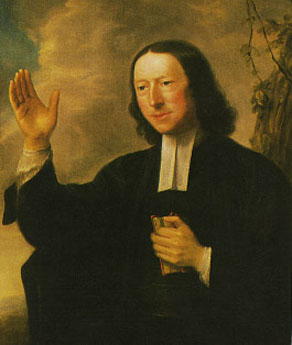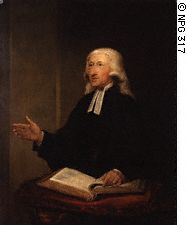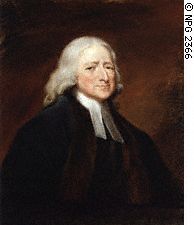Portraits of John Wesley are common in Methodist churches, parsonages, and seminaries. Let's have a look at the artists behind several of them.

This work of oil on canvas was executed by
Nathaniel Hone (1718-1784) in roughly 1766. He was an Irish painter of portraiture and miniature. Hone had no formal artistic education, but settled in London and was soon commercially successful. He was a founding member of the Royal Academy in 1768. Hone was an ardent proponent of Dutch, rather than Italian Classicism, which brought him into a number of personal conflicts with other RA members, most notably
Joshua Reynolds. While Reynolds was President, Hone released for exhibition
Pictorial Conjurer, a subtle attack on Reynolds' style. This painting alleged an affair between Reynolds and artist
Angelica Kauffman. When this work was rejected from the Royal Academy, Hone responded by hosting a one-man show -- the first in the history of Western art.
 Frank O. Salisbury
Frank O. Salisbury (1874-1962) obviously did not paint Wesley from life, but his depiction is a commonly-known one. Salisbury, a native of Herfordshire, created portraits, murals, and stained glass. His career began meagerly in a borrowed attic studio while he worked as a bicycle mechanic. Eventually, Salisbury became one of Britain's most prominent portraitists. He reached the height of his prominence during World War II, when he became the quasi-official portraitist of the Anglo-American political elite. Salisbury adored America and eventually five U.S. Presidents sat for him.

I wish that I could make a bigger picture of
William Hamilton's (1751-1801) portrait of Wesley (1788), but this is the best that I could do. Born in Chelsea, he trained in Rome, Zurich, and London. Hamilton exhibited at the Royal Academy from 1774 until his death, becoming a member in 1784.
 George Romney
George Romney (1734-1802), a native of Cumbria, was initially apprenticed as a cabinet-maker. He later studied painting under
Christopher Steele and set up a successful portrait business. Seven years later he abandoned his wife and son to seek his fortune in London. After a decade of unhappiness painting only portraits, he left for Rome where he studied the Old Masters. Returning to London, he became a great commercial success by painting portraits at nearly the quality of
Reynolds and
Gainsborough, but at much lower prices. Although offered membership in the Royal Academy, Romney declined the recognition. He composed this depiction of John Wesley in 1789.
 This work of oil on canvas was executed by Nathaniel Hone (1718-1784) in roughly 1766. He was an Irish painter of portraiture and miniature. Hone had no formal artistic education, but settled in London and was soon commercially successful. He was a founding member of the Royal Academy in 1768. Hone was an ardent proponent of Dutch, rather than Italian Classicism, which brought him into a number of personal conflicts with other RA members, most notably Joshua Reynolds. While Reynolds was President, Hone released for exhibition Pictorial Conjurer, a subtle attack on Reynolds' style. This painting alleged an affair between Reynolds and artist Angelica Kauffman. When this work was rejected from the Royal Academy, Hone responded by hosting a one-man show -- the first in the history of Western art.
This work of oil on canvas was executed by Nathaniel Hone (1718-1784) in roughly 1766. He was an Irish painter of portraiture and miniature. Hone had no formal artistic education, but settled in London and was soon commercially successful. He was a founding member of the Royal Academy in 1768. Hone was an ardent proponent of Dutch, rather than Italian Classicism, which brought him into a number of personal conflicts with other RA members, most notably Joshua Reynolds. While Reynolds was President, Hone released for exhibition Pictorial Conjurer, a subtle attack on Reynolds' style. This painting alleged an affair between Reynolds and artist Angelica Kauffman. When this work was rejected from the Royal Academy, Hone responded by hosting a one-man show -- the first in the history of Western art. Frank O. Salisbury (1874-1962) obviously did not paint Wesley from life, but his depiction is a commonly-known one. Salisbury, a native of Herfordshire, created portraits, murals, and stained glass. His career began meagerly in a borrowed attic studio while he worked as a bicycle mechanic. Eventually, Salisbury became one of Britain's most prominent portraitists. He reached the height of his prominence during World War II, when he became the quasi-official portraitist of the Anglo-American political elite. Salisbury adored America and eventually five U.S. Presidents sat for him.
Frank O. Salisbury (1874-1962) obviously did not paint Wesley from life, but his depiction is a commonly-known one. Salisbury, a native of Herfordshire, created portraits, murals, and stained glass. His career began meagerly in a borrowed attic studio while he worked as a bicycle mechanic. Eventually, Salisbury became one of Britain's most prominent portraitists. He reached the height of his prominence during World War II, when he became the quasi-official portraitist of the Anglo-American political elite. Salisbury adored America and eventually five U.S. Presidents sat for him. I wish that I could make a bigger picture of William Hamilton's (1751-1801) portrait of Wesley (1788), but this is the best that I could do. Born in Chelsea, he trained in Rome, Zurich, and London. Hamilton exhibited at the Royal Academy from 1774 until his death, becoming a member in 1784.
I wish that I could make a bigger picture of William Hamilton's (1751-1801) portrait of Wesley (1788), but this is the best that I could do. Born in Chelsea, he trained in Rome, Zurich, and London. Hamilton exhibited at the Royal Academy from 1774 until his death, becoming a member in 1784. George Romney (1734-1802), a native of Cumbria, was initially apprenticed as a cabinet-maker. He later studied painting under Christopher Steele and set up a successful portrait business. Seven years later he abandoned his wife and son to seek his fortune in London. After a decade of unhappiness painting only portraits, he left for Rome where he studied the Old Masters. Returning to London, he became a great commercial success by painting portraits at nearly the quality of Reynolds and Gainsborough, but at much lower prices. Although offered membership in the Royal Academy, Romney declined the recognition. He composed this depiction of John Wesley in 1789.
George Romney (1734-1802), a native of Cumbria, was initially apprenticed as a cabinet-maker. He later studied painting under Christopher Steele and set up a successful portrait business. Seven years later he abandoned his wife and son to seek his fortune in London. After a decade of unhappiness painting only portraits, he left for Rome where he studied the Old Masters. Returning to London, he became a great commercial success by painting portraits at nearly the quality of Reynolds and Gainsborough, but at much lower prices. Although offered membership in the Royal Academy, Romney declined the recognition. He composed this depiction of John Wesley in 1789.

5 comments:
John,
The Frank O. Salisbury portrait of Wesley is the one that I remember the most from my time growing up in church. We had that portrait somewhere in the back of the sanctuary. That is the one that comes to my mind with I think of the name John Wesley. I didn't know that he never met or saw the man. I wonder how realistic it is.?
There is a methodology to determining accurate portraiture before the age of photography, but I no longer remember its principles. I once met a scholar who devoted his entire career to examining Greco-Roman iconography to determine what the Ancients really looked like.
My first guess would be that the Hone and Hamilton pictures are the most accurate. They, at least, agree with each other about Wesley's facial features.
John,
Salisbury painted 3 posthumous portraits of Wesley. You have shown the most famous which is in Wesley's House in City Road, London. The others - which feature Wesley in more vivid clerical garb - are in Methodist Central Hall, Westminster and World Methodist HQ in North Carolina.
Salisbury used Charles Annesley Voysey, the nonconformist architect, as a model; Voysey was the great great great grandson of Sukey - one of John Wesley's sisters!
Though Salisbury made a fortune painting the elite and large canvases of royal occasions, he was a generous benefactor of the mainstream denominations - particularly Methodism.
In terms of accuracy of likeness, the 1781 bust by Enoch Wood was generally considered to be the best by people who had known Wesley. Of the four pictures you show, Wesley is only definitely recorded as having sat to Romney (January 1789), though possibly a reference in Dec 1787 to 'the painter' refers to the Hamilton portrait. However, there has been doubt about how sympathetic a portraitist Romney was to Wesley.
I have details of 12 portraits + 6 miniatures of Wesley 'from the life', plus several posthumous portraits, about 20 'scene paintings': some of these are known in multiple copies (10 copies of the Romney, for instance). Add to that statuary plus innumerable prints, not forgetting ceramics, and you have a complex field.
Peter Forsaith
Oxford
I found a picture gifted to the church in 1953, of John Wesley. It was in the cellar! The artist is Frank O Salisbury and is signed on the print.(I think it is a print) However there is also a pencil signature by F O S. Could this make the print of value?
Thanks,SJP
Post a Comment